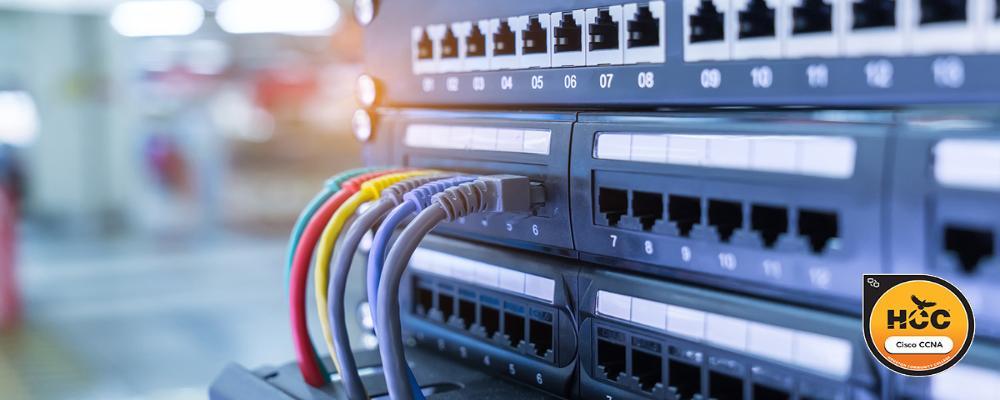Cisco CCNA
Cisco CCNA

The Cisco CCNA Micro-Cred training will prepare students for the latest CCNA certification (Implementing and Administering Cisco Solutions (CCNA) v1.0) released in February 24, 2020 which aligns with the 200-301 CCNA exam.
Attention Employers:
Students apply these skills to REAL JOBS in REAL TIME
Learn More
Course listing
ITCC 1014 CCNA 1: Introduction to Networks 96hrs - Enroll
ITCC 1044 CCNA 2: Switching, Routing & Wireless Essentials 96hrs - Enroll
Cyber Range scenario: DDOS SYN Flood (1hr) - Enroll
ITCC 2020 CCNA 3: Enterprise Networking, Security, and Automation 96hrs - Enroll
Cyber Range scenario: Router SIEM Disable (3hrs) - Enroll
Cyber Range scenario: DDOS DNS Amplification (2hrs) - Enroll
Books and labs
ITCC 1014 (CCNA 1), ITCC 1044 (CCNA 2), ITCC 2020 (CCNA 3) material and labs included for free to HCC students as a Cisco Academy.
The Cisco training also includes labs on a state-of-the art Cyber Range thanks to HCC being a strong cyber security school (CAE2Y designation holders backed by the NSA/DHS). The scenarios are included for free as part of the training (a $400 value for each scenario and $1200 added-value for the training camp!).
Cyber Range scenario: DDOS SYN Flood (1hr)
An attacker uses many internet bots to generate a large amount of traffic on one of the organization’s web sites. The traffic floods, and eventually overloads the bandwidth and resources of the target, crippling the server and causing a denial-of-service (DoS) to the web server
Cyber Range scenario: Router SIEM Disable (3hrs)
An attacker uses a brute force attack to gain access to the public router. Upon successful login, the attacker modifies the router configuration to redirect users to a malicious payload. When the payload is executed, a remote session is established with the attack machine, leading to much more damage.
Cyber Range scenario: DDOS DNS Amplification (2hrs)
Your organization’s DNS server is used to conduct a much wider DNS amplification attack, which is a reflection-based distributed denial of service (DDoS) attack on a target. The large number of DNS responses are sent "back" to the target as if it requested them, flooding the bandwidth and resources of the target, crippling the server and causing a denial-of-service (DoS).
Cost
Cost: $2535 ($2535 tuition $0 books/labs) total hours 288
Format
Online on a schedule (Mix of self-paced & instructor led)
Learning Outcomes
- Identify the components of a computer network and describe their basic characteristics
- Understand the model of host-to-host communication
- Describe the features and functions of the Cisco Internetwork Operating System (IOS®) software
- Describe LANs and the role of switches within LANs
- Describe Ethernet as the network access layer of TCP/IP and describe the operation of switches
- Install a switch and perform the initial configuration
- Describe the TCP/IP Internet layer, IPv4, its addressing scheme, and subnetting
- Describe the TCP/IP Transport layer and Application layer
- Explore functions of routing
- Implement basic configuration on a Cisco router
- Explain host-to-host communications across switches and routers
- Identify and resolve common switched network issues and common problems associated with IPv4 addressing
- Describe IPv6 main features and addresses, and configure and verify basic IPv6 connectivity
- Describe the operation, benefits, and limitations of static routing
- Describe, implement, and verify Virtual Local Area Networks (VLANs) and trunks
- Describe the application and configuration of inter-VLAN routing
- Explain the basics of dynamic routing protocols and describe components and terms of Open Shortest Path First (OSPF)
- Explain how Spanning Tree Protocol (STP) and Rapid Spanning Tree Protocol (RSTP) work
- Configure link aggregation using EtherChannel
- Describe the purpose of Layer 3 redundancy protocols
- Describe basic WAN and VPN concepts
- Describe the operation of Access Control Lists (ACLs) and their applications in the network
Configure Internet access using Dynamic Host Configuration Protocol (DHCP) clients and explain and configure Network Address Translation (NAT) on Cisco routers
- Describe basic Quality of Service (QoS) concepts
- Describe the concepts of wireless networks, which types of wireless networks can be built, and how to use Wireless LAN Controllers (WLCs)
- Describe network and device architectures and introduce virtualization
Introduce the concept of network programmability and Software-Defined Networking (SDN) and describe smart network management solutions such as Cisco DNA Center™, Software-Defined Access (SD-Access), and Software-Defined Wide Area Network (SD-WAN)
- Configure basic IOS system monitoring tools
- Describe the management of Cisco devices
- Describe the current security threat landscape
- Describe threat defense technologies
- Implement a basic security configuration of the device management plane
- Implement basic steps to harden network devices
HCC’s Micro-LEARNING courses are especially appealing for working professionals and others who need a flexible means of taking classes. HCC’s Micro-LEARNING courses also earn you college credit, so you can also start you on the path to a certificate or a college degree.
Samir Saber
Information Technology
